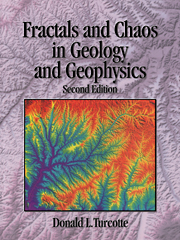Book contents
- Frontmatter
- Contents
- Preface
- Preface to the second edition
- 1 Scale invariance
- 2 Definition of a fractal set
- 3 Fragmentation
- 4 Seismicity and tectonics
- 5 Ore grade and tonnage
- 6 Fractal clustering
- 7 Self-affine fractals
- 8 Geomorphology
- 9 Dynamical systems
- 10 Logistic map
- 11 Slider-block models
- 12 Lorenz equations
- 13 Is mantle convection chaotic?
- 14 Rikitake dynamo
- 15 Renormalization group method
- 16 Self-organized criticality
- 17 Where do we stand?
- References
- Appendix A Glossary of terms
- Appendix B Units and symbols
- Answers to selected problems
- Index
5 - Ore grade and tonnage
Published online by Cambridge University Press: 05 June 2012
- Frontmatter
- Contents
- Preface
- Preface to the second edition
- 1 Scale invariance
- 2 Definition of a fractal set
- 3 Fragmentation
- 4 Seismicity and tectonics
- 5 Ore grade and tonnage
- 6 Fractal clustering
- 7 Self-affine fractals
- 8 Geomorphology
- 9 Dynamical systems
- 10 Logistic map
- 11 Slider-block models
- 12 Lorenz equations
- 13 Is mantle convection chaotic?
- 14 Rikitake dynamo
- 15 Renormalization group method
- 16 Self-organized criticality
- 17 Where do we stand?
- References
- Appendix A Glossary of terms
- Appendix B Units and symbols
- Answers to selected problems
- Index
Summary
Ore-enrichment models
Statistical treatments of ore grade and tonnage for economic ore deposits have provided a basis for estimating ore reserves. The objective is to determine the tonnage of ore with grades above a specified value. The grade is defined as the ratio of the mass of the mineral extracted to the mass of the ore. Evaluations can be made on either a global or a regional basis. Much of the original work on this problem was carried out by Lasky (1950). He argued that ore grade and tonnage obey log-normal distributions.
Other authors, however, have suggested that a linear relation is obtained if the logarithm of the tonnage of ore with grades above a specified value is plotted against the logarithm of the grade. The latter is a fractal relation. A fractal relation would be expected if the concentration mechanism is scale invariant. Many different mechanisms are responsible for the concentrations of minerals that lead to economic ore deposits. Probably the most widely applicable mechanisms are associated with hydrothermal circulations.
We first consider two simple models that illustrate the log-normal and power-law distributions for tonnage versus grade. De Wijs (1951, 1953) proposed the model for mineral concentration that is illustrated in Figure 5.1 (a). In this model an original mass of rock M0 is divided into two equal parts each with a mass M1 = M0/2. The original mass of the rock has a mean mineral concentration C0, which is the ratio of the mass of mineral to mass of rock.
- Type
- Chapter
- Information
- Fractals and Chaos in Geology and Geophysics , pp. 81 - 99Publisher: Cambridge University PressPrint publication year: 1997



